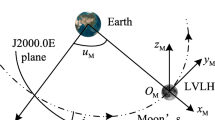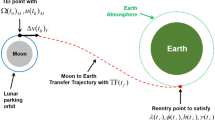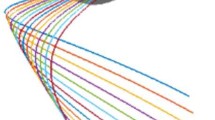Abstract
A circumlunar free return orbit design model that satisfies manned lunar mission constraints is established. By combining analytical method with numerical method, a serial orbit design strategy from initial value design to precision solution is proposed. A simulation example is given, and the conclusion indicates that the method has excellent convergence performance and precision. According to a great deal of simulation results solved by the method, the free return orbit characters such as accessible moon orbit parameters, return orbit parameters, transfer delta velocity, etc. are analyzed, which can supply references to constitute manned lunar mission orbit scheme.
Similar content being viewed by others
References
Berry R L. Launch window and translunar orbit, lunar orbit, and transearth trajectory planning and control for the Apollo 11 lunar landing mission. In: AIAA 8th Aerospace Sciences Meeting, AIAA 70-0024. New York: AIAA, 1970
Caldwell S F, Mummert V S. Apollo free return reentry point analysis. NASA-CR-78347, 1966
Dupont A L, Bell J A, Alexander J D. Preliminary abort and rescue procedures for Apollo mission F. NASA-TM-X-69838, 1969
Beksinski E D. Abort trajectory for manned lunar missions. Dissertation of Masteral Degree. Maryland: Unversity of Maryland, 2007
Battin R H. An Introduction to the Mathematics and Methods of Astrodynamics. Reston: American Institute of Aeronautics and Astronautics, Inc., 1999
Huang W D, Xi X N, Wang W, et al. Characteristic analysis and design of free return orbit for manned lunar landing based on the double two-body model (in Chinese). J Astron, 2010, 31: 1297–1303
Liu X L, Dun G R. Designs of optimal free-return orbit for moon landing. In: Proceedings of the 2007 IEEE International Conference on Robotics and Biomimetics. Sanya: IEEE, 2007. 936–940
Zhang L, Yu D Y, Zhang H. Design and analysis of circumlunar free return orbit (in Chinese). Spacecraft Eng, 2010, 19: 128–135
Jesick M, Ocampo C. Automated generation of symmetric lunar free-return trajectories. J Guid, Contr, Dynam, 2011, 34: 98–106
Luo Y Z, Tang G J, Lei Y J, et al. Optimization of multiple-impulse, multiple-revolution, rendezvous-phasing maneuvers. J Guid, Contr, Dynam, 2007, 30: 946–952
Xi X N, Zeng G Q, Ren X, et al. Orbit Design of Lunar Probe (in Chinese). Beijing: National Defense Industry Press, 2001. 51–130
Liu L, Wang X. An Orbital Dynamics of Lunar Probe (in Chinese). Beijing: National Defense Industry Press, 2006. 15–50
Huang W D, Xi X N, Wang W. Characteristic analysis and design of hybrid trajectory for manned lunar landing mission based on double two-body model (in Chinese). J Nat U Def Tech, 2010, 32: 61–67
Li Z J, Liu X D, Duan X D. Simulation on particle swarm optimization for space locus problem (in Chinese). J Sys Simul, 2009, 21: 6086–6090
Author information
Authors and Affiliations
Corresponding author
Rights and permissions
About this article
Cite this article
Peng, Q., Shen, H. & Li, H. Free return orbit design and characteristics analysis for manned lunar mission. Sci. China Technol. Sci. 54, 3243–3250 (2011). https://doi.org/10.1007/s11431-011-4622-7
Received:
Accepted:
Published:
Issue Date:
DOI: https://doi.org/10.1007/s11431-011-4622-7




